Vietnam People's Air Force
| Vietnam People's Air Force Không Quân Nhân Dân Việt Nam | |
|---|---|
|
Vietnam People's Air Force emblem | |
| Active | 1959 – present |
| Country | Vietnam |
| Branch |
Five branches
|
| Size |
35,000 personnel (2009) 551 active aircraft |
| Part of | Vietnam People's Army |
| Colors | Azure, Dark Green |
| Anniversaries | October 22, 1963 |
| Engagements |
First Indochina War Vietnam War Cambodian-Vietnamese War Sino-Vietnamese War |
| Decorations |
|
| Battle honours |
Operation Linebacker Operation Linebacker II The 1975 Spring Offensive |
| Commanders | |
| Commander | Lieutenant General Phuong Minh Hoa |
| Political Commissar | Major General Nguyen Van Thanh |
| Chief of Staff | Major General Nguyen Van Tho |
| Insignia | |
| Flag of Vietnam People's Air Force |
 |
| Roundel |
|
| Wings |
|
| Awards |
|
| Aircraft flown | |
| Attack | Su-22, Mi-24 |
| Fighter | Su-30, Su-27, MiG-21 |
| Patrol | Ka-27, Ka-25 |
| Reconnaissance | M-400, An-30 |
| Trainer | Yak-52, L-39 |
| Transport | An-38, M-28, An-24, An-26, UH-1, Mi-8, Mi-17 |
The Vietnam People's Air Force (Vietnamese: Không quân Nhân dân Việt Nam) is the air force of Vietnam. It is the successor of the former North Vietnamese Air Force and absorbed the Republic of Vietnam Air Force following the re-unification of Vietnam in 1975. The Vietnam People's Air Force (VPAF) is one of three main branches in the Vietnam People's Army which is a part of the Ministry of Defence. The main mission of the VPAF is the defence of Vietnamese airspace and the provision of air cover for operations of the Vietnam People's Army.
History
Beginning-1964 (North Vietnam)
The first aircraft in service for the Vietnamese Armed Forces were two trainers, a de Havilland Tiger Moth and a Morane-Saulnier, which were initially the private property of the emperor Bảo Đại.[1] In 1945, Bảo Đại gave the aircraft to the Vietnamese government. Until 1950, even though the Vietnam People's Army (VPA) had acquired credible offensive capabilities on the ground, it was almost powerless against reconnaissance or attacking operations from the French Expeditionary Air Force. On March 9, 1949, General Vo Nguyen Giap was authorized to establish the Air Force Research Committee (Ban Nghiên cứu Không quân) under the General Staff to study ways to deal with the air war. The first Vietnamese service aircraft flight was made by the Tiger Moth on August 15, 1949.[1] A small-scale training was carried out in the following years.
Further development of aviation in North Vietnam began in 1956, when a number of trainees were sent to the USSR and China for pilot training. They were organized into two groups, for pilots and mechanics, respectively; and among others, utilized the Czechoslovak Zlín Z-226 and Aero Ae-45. The first unit of the VPAF was the No. 919 Transport Regiment (Trung đoàn Không quân Vận tải 919), organized on May 1, 1959, with An-2, Li-2, Il-14 aircraft, followed by the No. 910 Training Regiment (Trung đoàn Không quân 910) with Yak-18 trainers.[1] In 1963 the Air Force and Air Defense Force were merged into the Air and Air Defence Force (Quân chủng Phòng không – Không quân).
1964–74 (North Vietnam)
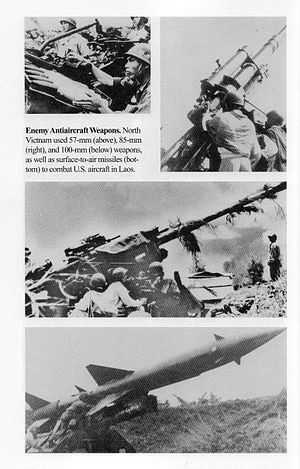
The first North Vietnamese combat plane was a T-28 Trojan trainer, whose pilot defected from the Royal Lao Air Force; it was utilized from early 1964 by the North Vietnamese as a night fighter. The T-28 was the first North Vietnamese aircraft to shoot down a U.S. aircraft, a C-123, on February 15, 1964.[1]
The North Vietnamese Air Force (NVAF) received its first jet fighter aircraft, the MiG-17 in February 1964, but they were initially stationed at air bases on Mainland China, while their pilots were being trained. On February 3, 1964, the first fighter regiment No. 921 (Trung đoàn Không quân Tiêm kích 921), aka "Red Star squadron", was formed, and on August 6 it arrived from China in North Vietnam with its MiG-17s.[1] On September 7, the No. 923 fighter regiment, aka "Yen The Squadron", led by Lt. Col. Nguyen Phuc Trach, was formed. In May 1965, No. 16 bomber company (Đại đội Không quân Ném bom 16) was formed with Il-28 twin engine bombers. Only one Il-28 sortie was flown in 1972 against Royal Laotian forces.
.jpg)

The North Vietnamese Air Force's first jet air-to-air engagement with U.S. aircraft was on April 3, 1965. The NVAF claimed the shooting down of two US Navy F-8 Crusader, which was not confirmed by US sources, although they acknowledged having encountered MiGs.[1] Consequently, April 3 became "North Vietnamese Air Force Day". On April 4 the VPAF (NVAF) scored the first confirmed victories to be acknowledged by both sides. The US fighter community was shocked when relatively slow, post-Korean era MiG-17 fighters shot down advanced F-105 Thunderchief fighters-bombers attacking the Thanh Hóa Bridge. The two downed F-105s were carrying their normal heavy bomb load, and were not able to react to their attackers.[1]
In 1965, the NVAF were supplied with supersonic MiG-21s by the USSR which were used for high speed GCI controlled hit and run intercepts against American air strike groups. The MiG-21 tactics became so effective, that by late 1966, an operation was mounted to especially deal with the MiG-21 threat. Led by Colonel Robin Olds on 2 January 1967, Operation Bolo lured MiG-21s into the air, thinking they were intercepting a F-105 strike group, but instead found a sky full of missile armed F-4 Phantom IIs set for aerial combat. The result was a loss of almost half the inventory of MiG-21 interceptors, at a cost of no U.S. losses. The VPAF (NVAF) stood down for additional training after this setback.
Meanwhile, the disappointing performances of US Air Force and US Navy (USN) airmen, even though flying the contemporary advanced aircraft of those times, combined with a legacy of successes from World War II and the Korean War, resulted in a total revamping of aerial combat training for the USN in 1968 (Top Gun school; established 1969). The designs for an entire generation of aircraft, with engineering for optimized daylight air-to-air combat (dog fighting) against both older, as well as for emerging MiG fighters, were being put to the drawing board. US forces could not consistently track low flying MiGs on radar, and were hampered by restrictive rules of engagement (ROE) which required pilots to visually acquire their targets, nullifying much of the advantage of radar guided missiles, which often proved unreliable when used in combat.
The VPAF (NVAF) was a defensive air arm, with the primary mission of defending North Vietnam, and until the last stages of the war, did not conduct air operations into South Vietnam; nor did the NVAF conduct general offensive actions against enemy naval forces off the coast. However it did conduct limited attacks on the opposing naval vessels, notably damaging the United States destroyer USS Higbee in 1972. In a separate incident, MiG-17s that ventured over water were shot down by surface-to-air missiles (SAMs) fired by U.S. warships.


The VPAF (NVAF) did not engage all US sorties. Most US aircraft were destroyed by SA-2 surface-to-air missiles or anti-aircraft artillery (AAA), and in some cases, even small arms. Typically, VPAF MiGs would not engage unless it was to their advantage. Some of the aerial tactics used were similar to Operation Bolo, which lured the NVAF to the fight.
On March 24, 1967, regiments Nos. 921, 923 and 919 were incorporated into the 371st Air Division "Thăng Long" (Sư đoàn Không quân 371). In 1969, No. 925 fighter regiment was formed, flying the Shenyang J-6 (the Chinese-built MiG-19). In 1972 the fourth fighter regiment, No. 927 "Lam Son", was formed.[1]
VPAF flew their interceptors with superb guidance from ground controllers, who positioned the MiGs in perfect ambush battle stations. The MIGs made fast and devastating attacks against US formations from several directions (usually the MiG-17s performed head-on attacks and the MiG-21s attacked from the rear). After shooting down a few American planes and forcing some of the F-105s to drop their bombs prematurely, the MiGs did not wait for retaliation, but disengaged rapidly. This "guerrilla warfare in the air" proved very successful. In December 1966 the MiG-21 pilots of the 921st FR downed 14 F-105s without any losses.[4]
The U.S Air Force and the U.S. Navy continued to lay down great expectations on the F4 Phantom, assuming that the massive arms, the perfect on-board radar, the highest speed and acceleration properties, coupled with the new tactics will provide "Phantoms" an advantage over the MiGs. But in collisions with lighter VPAF's MiG-21, F-4 began to suffer defeat. From May to December 1966, the U.S. air battles lost 47 aircraft, destroying all of this only 12 enemy's fighters. From April 1965 to November 1968, over North Vietnam was conducted 268 air battles, VPAF claimed shot down 244 U.S. or ARVN's aircraft, and they lost 85 MiGs (including 27 F-4s and 20 MiG-21s).[5]
In the spring and summer of 1972, to illumine the theater of war 360 tactical fighters of the U.S. Air Force and 96 Navy fighter, a great number of which were F4 Phantom of recent modifications, opposed only 71 VPAF's aircraft (including 31 MiG-21) was a militant.[5]
The culmination of the struggle in the air in the spring of 1972 was May 10, when the VPAF's aircraft completed 64 sorties, spending 15 air battles. VPAF claimed 7 F-4s were shot down (U.S confirmed five F4s were lost[6]). Those, in turn, managed to kill two MiG-21s, three MiG-17s and one MiG-19. May 11, two MiG-21, who played the role of "bait", brought the four F-4 to 2-circled at low altitude MiG-21. MiGs quickly stormed the "Phantoms" and 3 missiles shot down two F-4. May 18, Vietnamese aircraft made 26 sorties and spent eight air combat, which cost the 4 F4 Phantom, Vietnamese fighters on that day did not suffer losses. June 13, MiG-21 unit intercepted a group of F-4, the second pair of MiGs made a missile attack and was hit by two F-4 and did not suffer losses.[5]
Over the course of the air war, between 3 April 1965[7] and 8 January 1973, each side would ultimately claim favorable kill ratios. A total of 1972 between American and Vietnamese planes took 201 air battle. VPAF lost 54 MiGs (including 36 MiG-21s and one MiG-21US) and they claimed 90 U.S aircraft were shot down (including 73 F-4 fighter and two spy RF-4C)[5]
U.S. Navy ace Randy Cunningham believed that he shot down a Mig-17 piloted by the mythical "Nguyen Toon" or "Colonel Tomb" while flying his F4 Phantom. However, no research has been able to identify Col. Tomb's existence; Cunningham most likely downed a flight leader of the 923rd Regiment. Legend states Col. Toon downed 13 US aircraft during his tenure.[8] Many North Vietnamese pilots were not only skilled but unorthodox, as Cunningham found out after making elementary tactical errors.[9] The resulting dogfight became extended. Cunningham climbed steeply, and the MiG pilot surprised Cunningham by climbing as well. Using his Top Gun training, Cunningham finally forced the MiG out ahead of him and destroyed it. In fact, there wasn't any pilot in VPAF named Nguyễn Toon, he was a fictional character of the American pilots and they often made jokes with the dissertation. As a goodwill of the American pilots, Colonel Toon was a combination of good pilots in Vietnam, like the "solo artist" lonely night bombing in World War II was called Washing Machine Charlie.
There were several times during the war that the U.S. bombing restrictions of North Vietnamese Airfields were lifted. Many VPAF (NVAF) aircraft were destroyed on the ground, and those that were not, were withdrawn to a sanctuary in the north west of the country or in China. In December 1972, the North Vietnamese air defences nearly exhausted their supply of surface-to-air missiles trying to down the high-flying B-52 raids over the North. The North Vietnamese Air Defense Network was degraded by electronic countermeasures (ECM) and other suppression of Enemy Air Defenses (SEAD) measures. Though the North Vietnamese forces claim over 81 US aircraft as shot down during Operation Linebacker II, (including 34 B-52s, two attributed to the VPAF),[10], U.S sources acknowledge only 27 aircraft lost by the Americans (including 15 B-52s).[11]
Within 12 days of the operation "Linebacker-2" (18–29 December), during the eight air battles were shot down seven U.S. aircraft (including four F4 Phantom) and three Vietnamese MiG-21.[5]
After the negotiated end of American involvement in early 1973, the No. 919 transport air group (Lữ đoàn Không quân vận tải 919), was formed; and equipped with fixed-wing aircraft, as well as helicopters (rotor-wing) in November.
During the 1975 Spring Offensive, the bombing of Tan Son Nhut Air Base, the only airstrike conducted by the VPAF, occurred on April 28, 1975, just two days before the Fall of Saigon. The operation was carried out by the VPAF's Quyet Thang Squadron, using captured A-37s aircraft flown by hero pilot Nguyen Thanh Trung who had bombed the Presidential Palace in Saigon, less than one month earlier before defecting to the north.
During the Vietnam War, NVAF used the MiG-17F, PF (J-5); MiG-19 (J-6), MiG-21F-13, PF, PFM and MF fighters.[1] They claimed to have shot down 266 US aircraft, and US claimed to have shot down or destroyed 204 MiGs aircraft and at least six An-2s, of which 196 were confirmed with solid evidence (100 MiG-17s, 10 MiG-19s and 86 MiG-21s). However, VPAF admits only 154 MiGs were lost through all causes, including 131 in air combat (63 MiG-17s, 8 MiG-19s and 60 MiG-21s)[12]). Like that, total kill ratio would be 1:1.3 to 1:2.[13][14] With the number of losses to MiGs confirmed by US (121 aircraft shotdown and 7 damaged[13][14]), the kill ratio turn 1.6:1 against the MiGs, or 1.1:1 even accepting the VPAF's figure of only 131 in air combat. However, this ratio does not include the number of ARVN's aircraft shot down by VPAF (One source claims 72 ARVN's aircraft were shot down by VPAF[15])
1975–present (reunified Vietnam)
The VPAF did not play a major role during the Ho Chi Minh Campaign in 1975. The only sorties flown were conducted by five captured VNAF A-37s. SA-2s were transported into South Vietnam to counter possible US military air strikes. The US could not bring back their air power during the 1975 offensive, which had proven decisive in 1972, and the VNAF did not have the capability to strike targets in the north nor to defend against the onslaught in the south.
After the end of the Vietnam War (called the American War in Vietnam) in May 1975, more regiments were formed. No. 935 fighter regiment "Đồng Nai" and no. 937 fighter-bomber regiment "Hậu Giang", followed by no. 918 transport regiment "Hong Ha" and no. 917 mixed transport regiment "Đồng Tháp" were created in July 1975. In September 1975, the four newly created regiments were formed into the 370nd Air Division "Lê Lợi" and the 372nd Air Division "Hai Van" was formed, including among others the 925th fighter regiment.[1]
On May 31, 1977, the Vietnam People's Air Force (Không quân Nhân dân Việt Nam) was separated from the Air Defense Force (Quân chủng Phòng không).[1]
When South Vietnam was overrun by PAVN forces on 30 April 1975, approximately 877 aircraft were captured by PAVN. Of that number, 41 were F-5s and 95 were A-37s.[16] When Vietnam invaded Cambodia in 1979, former VNAF A-37s flew most of the ground support missions. These aircraft were more suited to the role than the MiGs. Former VNAF F-5Es, C-123s, C-130s, and UH-1s were used by the VPAF for many years after the end of the War.
In the years between 1953 and 1991, approximately 700 warplanes, 120 helicopters, and 158 missile complexes have been supplied to North Vietnam by the USSR and PR China (primarily the MiG-19 (J6 series). Even today, three-quarters of Vietnamese weaponry has been made in post-Cold-War Russia.[17]
Today the VPAF is in the midst of modernization. It still operates late model MiG-21s, Su-22s, aircraft of the Cold War era.[18][19] However, it has recently been modernizing its air force with models of the Su-27-SK air superiority fighter following closer military ties, and an array of arms deals with Russia. To date, Vietnam has ordered and received 12 of these aircraft. In 2004, it also acquired 4 modified variants of the Su-30 MK2V, newer models of the Su-27. In May 2009, they have inked a deal to procure additional 12 aircraft from the Russian to bolster their aging fleet. The Vietnamese air force has also acquired new advanced air defense systems, including two S-300 PMU1 (NATO designation: SA-20) short-to-high altitude SAM batteries in a deal worth $300 million with Russia.[17]
A twin-engine light transport aircraft of the 918th Transport Regiment crashed into a field on the outskirts of the capital Hanoi (Thanh Tri District) on Tuesday morning 8 April 2008 during a training mission, killing five Vietnamese military pilots. The plane took off from Gia Lam Airport in Hanoi, Northern Vietnam, with five officers aboard for a training exercise. It crashed on its way back to the airport.
Aerial aces
In Vietnam War, many Vietnamese pilots had notable achievements, and were honored in as "aces".[20]
| Name | Victories | VPAF Aircraft | Regiment | Service |
|---|---|---|---|---|
| Nguyễn Văn Cốc | Eleven kills (nine aircraft and two UAV) | MiG-21 | 921st Fighter Regiment | 1967–69 |
| Mai Văn Cường | Eight kills | MiG-21 | 921st Fighter Regiment | 1966–68 |
| Nguyễn Hồng Nhị | Eight kills | MiG-21 | 921st/927th Fighter Regiment | 1966–72 |
| Phạm Thanh Ngân | Eight kills | MiG-21 | 921st Fighter Regiment | 1967–69 |
| Đặng Ngọc Ngự | Seven kills | MiG-21 | 921st Fighter Regiment | 1966–72 |
| Nguyễn Văn Bảy | Seven kills | MiG-17 | 923rd Fighter Regiment | 1966–72 |
| Lê Hải | Six kills | MiG-17 | 923rd Fighter Regiment | 1967–72 |
| Lê Thanh Đạo | Six kills | MiG-21 | 927th Fighter Regiment | 1971–72 |
| Lưu Huy Chao | Six kills | MiG-17 | 923rd Fighter Regiment | 1966–68 |
| Nguyễn Đăng Kỉnh | Six kills | MiG-21 | 921st Fighter Regiment | 1967–68 |
| Nguyễn Đức Soát | Six kills | MiG-21 | 921st/927th Fighter Regiment | 1969–72 |
| Nguyễn Ngọc Độ | Six kills | MiG-21 | 921st Fighter Regiment | 1967–68 |
| Nguyễn Nhật Chiêu | Six Kills | MiG-17/MiG-21 | 921st Fighter Regiment | 1965–67 |
| Nguyễn Tiến Sâm | Six kills | MiG-21 | 921st/927th Fighter Regiment | 1968–72 |
| Vũ Ngọc Đỉnh | Six kills | MiG-21 | 921st Fighter Regiment | 1966–70 |
| Nguyễn Văn Nghĩa | Five kills | MiG-21 | 927th Fighter Regiment | 1972 |
About the other pilots, see Safarik's comprehensive list.[21]
Organizational structure
Air Force and Air Defense Divisions
The organizational levels of Vietnam People's Air Force, from highest to lowest are:
- High Command of Vietnam People's Air Force
- Air Division (Vietnamese: Sư đoàn không quân)
- Air Regiment (Vietnamese: Trung đoàn không quân)
- Air Flight (Vietnamese: Phi đội)
- Air Section (Vietnamese: Biên đội)
| |||||||||||||||||||||
Air Division and Regimental Names of the VPAF[22] Recent base information is from the Vietnamese Wikipedia VPAF article.
| Command | Division | Regiment | Name | Equipment | Base |
|---|---|---|---|---|---|
| High Command of Air Defense and Air Force | 371st Air Force Division (Thăng Long Air Wing) |
921st Fighter | Red Star Squadron | Su-22M-4/UM-3K | Phúc Yên Air Base |
| 923rd Fighter-bomber | Yen The Squadron | Su-30MK2 | Tho Xuan Airport | ||
| 927th Fighter | Lam Son Squadron | Su-30MK2 | Kép Air Base | ||
| 916th Helicopter | Ba Vi Squadron | Mi-6, Mi-8, Mi-24D, Mi-171 | Hòa Lạc Air Base | ||
| 918th Air Transport | Hong Ha Squadron | An-2, An-26, An-30, M-28, C-295M | Gia Lam Airport | ||
| 372nd Air Force Division (Hai Van Air Wing) |
929th Fighter-Bomber | Son Tra Squadron | Su-22M4,MiG-21 bis | Da Nang International Airport | |
| 930th Helicopter | Mi-8, Mi-171 | Da Nang International Airport | |||
| 940th Fighter/Air Training | Tây Sơn Squadron | Su-27SKM/UBK/PU | Phu Cat Airport | ||
| 370th Air Force Division (Lê Lợi Air Wing) |
937th Fighter-Bomber | Hậu Giang Squadron | Su-22M-4/UM-3K | Thanh Son Air Base | |
| 935th Fighter | Đồng Nai Squadron | Su-30MK2 | Bien Hoa Air Base | ||
| 917th Mixed Air Transport | Đồng Tháp Squadron | UH-1H, Mi-8, Mi-171 | Tan Son Nhat International Airport | ||
| Air Force Officer School | 910th Air Training | L-39C | Dong Tac Airport | ||
| 920nd Air Training | Yak-52 | Nha Trang Air Base | |||
| 361st Air Defense Division (Ha Noi Air Defense Division) |
218th SA Artillery | Hoa Lư Regiment | ZSU-23-4, SA-2 Guideline, SA-3 Goa, SA-9 Gaskin, SA-13 Gopher, SA-17 Grizzly, SA-20 Gargoyle, SA-22 Greyhound | Ha Noi | |
| 280th SA Artillery | Hong Linh Regiment | ||||
| 236th SA Missile | Song Da Regiment | ||||
| 250th SA Missile | Thăng Long Regiment | ||||
| 257th SA Missile | Red Flag Regiment | ||||
| 64th SA Missile | |||||
| 363rd Air Defense Division (Hai Phong Air Defense Division) |
240th AA Artillery | ZSU-23-4, SA-2 Guideline, SA-3 Goa, SA-9 Gaskin, SA-13 Gopher | Hai Phong | ||
| 213th SA Missile | |||||
| 238th SA Missile | Hạ Long Regiment | ||||
| 285th SA Missile | Nam Trieu Regiment | ||||
| 365th Air Defense Division (Bac Thai Air Defense Division) |
228th SA Artillery | Ham Rong Regiment | ZSU-23-4, SA-2 Guideline, SA-3 Goa, SA-9 Gaskin, SA-13 Gopher, SA-6 Gainful | Bắc Giang | |
| 267th SA Missile | Dien Bien Regiment | ||||
| 284th SA Missile | Song La Regiment | ||||
| 375th Air Defense Division (Da Nang Air Defense Division) |
224th SA Artillery | To Vinh Dien Regiment | SA-2 Guideline, SA-3 Goa, SA-6 Gainful | Da Nang | |
| 275th SA Missile | Soc Son Regiment | ||||
| 282nd SA Missile | Tam Giang Regiment | ||||
| 377th Air Defense Division (Khanh Hoa Air Defense Division) |
591st SA Artillery | Truong Son Regiment | SA-2 Guideline, SA-3 Goa, SA-6 Gainful, SA-17 Grizzly, SA-22 Greyhound | Cam Ranh | |
| 274th SA Missile | Hung Vuong Regiment | ||||
| 367th Air Defense Division (HCMC Air Defense Division) |
230th SA Artillery | Thong Nhat Regiment | SA-2 Guideline, SA-3 Goa, SA-6 Gainful, SA-20 Gargoyle | Ho Chi Minh city | |
| 261st SA Missile | Thanh Loa Regiment | ||||
| 263th SA Missile | Quang Trung Regiment | ||||
| 276th SA Missile | |||||
| 93rd SA Missile | |||||
Bases

Some airbases in the south were built by the French, Japanese* (World War II), United States Air Force or United States Navy for South Vietnam. The northern bases were likely built with assistance and/or use by the French, China or Soviet Union during the Vietnam War.
- Kép Air Base (VVKP)
- Bien Hoa Air Base (VVBH/VBH)
- Đồng Hới Airport (VVDH/VDH)
- Hòa Lạc Air Base (VVHL/VHL)
- Gia Lam Airbase (VVGL/VGL)
- Anh Son Airfield
- Thanh Son Airbase (VVPR/VPR)
- Tho Xuan Airport – (VVTX) training school for Vietnam fighter pilot.
- Truong Sa Airfield (VVSA)
- Tan Son Nhut Air Base (VVTS)
- Yên Bái Air Base – (VVYB) training school for Vietnam fighter pilot.
- Cam Ranh Airport (VVCR/CXR) – open for commercial flights in 2005
- Vũng Tàu Airfield (VVVT) operates for offshore helicopter services
- Cần Thơ Airfield – (VVCT/VCA) open and upgrade for logistic support air group.
- Phúc Yên Air Base – 921st Fighter Regiment
- Nha Trang Air Base
Air Force Museum
There are two Air Force museums in Vietnam: Vietnam People's Air Force Museum, Hanoi and Vietnam People's Air Force Museum, Ho Chi Minh City.
Service branches
| Aircraft | Air Defense Missiles | Air Defense Artillery | Paratroops | Radar Surveillance |
|---|---|---|---|---|
 |
 |
 |
 |
 |
Table of Ranks
Rank of Commander of Vietnam People's Air Force usually is Lieutenant General. Colonel General is very rarely used.
| Level | Ranks | Translation | Insignia |
|---|---|---|---|
| Flag Officers Sĩ quan cấp Tướng |
Thượng tướng | Colonel General | |
| Trung tướng | Lieutenant General | | |
| Thiếu tướng | Major General | | |
| Field Grade Officers Sĩ quan cấp Tá |
Đại tá | Senior Colonel | |
| Thượng tá | Colonel | | |
| Trung tá | Lieutenant Colonel | | |
| Thiếu tá | Major | | |
| Company Grade Officers Sĩ quan cấp Úy |
Đại úy | Captain | |
| Thượng úy | Lieutenant | | |
| Trung úy | Sub-lieutenant | | |
| Thiếu úy | Ensign | | |
| Officer cadets Học viên Sĩ quan |
Học viên Sĩ quan | Officer Cadet | |
| Non-Commissioned Officers Hạ sĩ quan |
Thượng sĩ | Sergeant Major | |
| Trung sĩ | Sergeant | | |
| Hạ sĩ | Corporal | | |
| Seamen Chiến sĩ |
Binh nhất | Airman First Class | |
| Binh nhì | Airman | | |
Aircraft inventory
Most of the VPAF's aircraft were supplied from the Soviet Union and PRC, but hundreds were left over by the United States via the Republic of Vietnam, most of which are no longer in service.
| style="background-color:#ffcc00;" "text-align: center;" width="130"|Photo | style="background-color:#ffcc00;" "text-align: center;" width="120"|Aircraft | style="background-color:#ffcc00;" "text-align: center;"|Origin | style="background-color:#ffcc00;" "text-align: center;" width="150"|Type | style="background-color:#ffcc00;" "text-align: center;" width="120"|Versions | style="background-color:#ffcc00;" "text-align: center;" width="100"|In service | style="background-color:#ffcc00;" "text-align: center;"|Notes |
|---|---|---|---|---|---|---|
| style="color:white; background-color:#3399FF;" "align: center; color=white;" colspan="7" | Trainer aircraft | ||||||
 |
Aero L-39 Albatros | |
Trainer | L-39C[23] | 26[24] | Subsonic jet trainer |
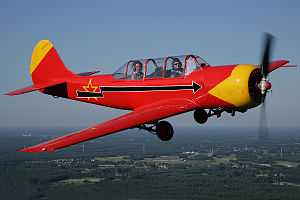 |
Yakovlev Yak-52 | |
Trainer | Yak-52 | 36 | Basic trainer aircraft. Version Iak-52 Trainer aircraft 2014 Assembled from kits in Viet Nam, delivery 2016–2018. Option on 24 more |
| style="color:white; background-color:#3399FF;" "align: center; color=white;" colspan="7" | Combat aircraft | ||||||
 |
Sukhoi Su-30MK2 | |
Multi-role fighter | Su-30MK2 |
36[25][26][27] | Russia completes delivery of all Su-30MK2 to Vietnam Air Force[27] |
 |
Sukhoi Su-27 | |
Air superiority fighter | Su-27SK/UBK[28] | 12[25] | Su-27SK: 7 Su-27UBK: 5 [29] |
 |
Sukhoi Su-22 | |
Ground attack | Su-22M3 Su-22M4 Su-22UM3K |
36[25][30] | Flight Global reported that 38 aircraft in service as 2014.Two aircraft crashed in April 2015.[31] At least 50+ in storage 54 Su-22M3/M4 were upgrade in 1998 |
 |
Mikoyan-Gurevich MiG-21 | |
Air superiority fighter | MiG-21Bis | 144[25] | Flight Global reported that 144 aircraft in service as 2014 100 MiG-21 has the Bison upgrade package from India. This is the latest upgrade package of this aircraft |
| style="color:white; background-color:#3399FF;" "align: center; color=white;" colspan="7" | Transport aircraft | ||||||
 |
EADS CASA C-295 | |
Transport | C-295M | 1 | 2 on order[32] |
| Antonov An-24 | |
Transport | An-24 | unknown | ||
 |
Antonov An-26 | |
Transport | An-26 | 30[33] | |
 |
Antonov An-2 | |
Light transport | An-2TD | 15 | |
| |
PZL M28 Skytruck | |
Light transport | M-28 | 11 | In 2005, Vietnam bought 12 PZL M28-1Rs (M-28B) from Poland. In November 2005, 1 PZl M-28 of VPAF crashed in Gia Lam district, Hanoi. All three crewmembers died.[34] |
| style="color:white; background-color:#3399FF;" "align: center; color=white;" colspan="7" | Helicopter | ||||||
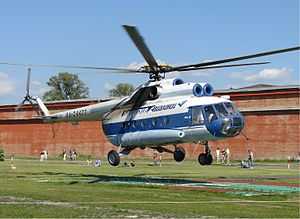 |
Mil Mi-8 | |
Transport helicopter | Mil Mi-8 | 70 | |
 |
Mil Mi-17 | |
Transport | Mil Mi-17/171 | 68 | |
| Mil Mi-24 | |
Attack helicopter | Mi-24A/D | 36 | ||
 |
UH-1H Huey | |
Utility | UH-1H | 14[24] | |
 |
Eurocopter Dauphin | |
SAR helicopter | SA-365 N2 | 6 | From the Ministry of Defence |
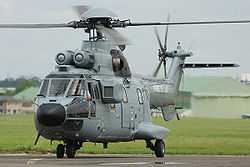 |
Aérospatiale Super Puma | |
Civilian transport | AS-332L2 | 8 | From the Ministry of Defence. One Super Puma operated by Southern Service Flight Company (SFC) was lost in sea transportation mission for offshore platform in 2007. |
| style="color:white; background-color:#3399FF;" "align: center; color=white;" colspan="7" | Miscellaneous Aircraft | ||||||
| AV.UAV.SM1[35] | |
UAV | unknown | unknown | ||
| AV.UAV.S1 | |
UAV | unknown | unknown | ||
| AV.UAV.S2[36] | |
UAV | unknown | unknown | ||
| AV.UAV.S3 | |
UAV | unknown | unknown | ||
| AV.UAV.S4 | |
UAV | Unknown | unknown | ||
| M-400 UAV | |
UAV | M400-CT | Currently used for air defenses training purpose. | ||
| VT Patrol | |
UAV | Unknown. | Tested in 2013, VT Patrol aircraft capable of flying at speeds of 100 to 150 km / h, 50 km distance operations, reconnaissance in full HD camera. The aircraft also operate slopes in inclement weather with temperatures about 10 °C, cloudy., . | ||
| VNS-41 | |
Amphibious | VNS-41 | 12 | Domestic produced light plane type ULM with floatation devices. | |
Air Defence
| style="background-color:#ffcc00;" "text-align: center;" width="130"|Photo | style="background-color:#ffcc00;" "text-align: center;" width="120"|Name | style="background-color:#ffcc00;" "text-align: center;"|Origin | style="background-color:#ffcc00;" "text-align: center;" width="120"|Type | style="background-color:#ffcc00;" "text-align: center;" width="120"|Versions | style="background-color:#ffcc00;" "text-align: center;" width="120"|No. of launchers | style="background-color:#ffcc00;" "text-align: center;" width="120"|No. of missiles | style="background-color:#ffcc00;" "text-align: center;"|Notes |
|---|---|---|---|---|---|---|---|
| style="color:white; background-color:#3399FF;" "align: center; color=white;" colspan="8" | Air Defence Missile | |||||||
 |
SA-20 Gargoyle (S-300) |
|
long range SAM system | S-300PMU-2 | 2 batteries, 12 launchers[17] | 75 missile | Fully upgraded. |
 |
SA-17 Grizzly (Buk-M2E) |
|
medium range SAM system | Buk-M2E | 6 batteries, 36 launchers | 200 9M317 missiles | Recently put on active duty. |
 |
SA-3 Goa (S-125 Neva/Pechora) |
|
surface-to-air missile | S-125 Pechora 2TM (upgraded version of SA-3) | 30+ systems | Unknown | |
| |
SA-2 Guideline (S-75 Dvina) |
|
surface-to-air missile | S-75 Volga 2MV (upgraded version of SA-2) | 30+ systems | 1000+ missiles | |
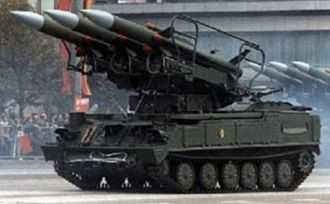 |
SA-6 Gainful (2K12 Kub) |
|
surface-to-air missile | SA-6 MV | 10+ systems | 1600 missiles | |
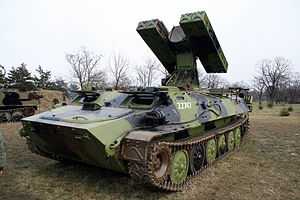 |
SA-13 Gopher (Strela-10) |
|
surface-to-air missile | Strela 10M3MV | 20 launchers | 200 missiles | Licensed produced in Vietnam |
| |
SA-7 Grail (Strela-2) |
|
Man-portable surface-to-air missile launcher | Strela 2M | 100 launchers | 350 missiles | |
 |
SA-24 Grinch (Igla) |
|
Man-portable surface-to-air missile launcher | Igla-S | 50 launchers | 400 missiles | Licensed produced in Vietnam |
| style="color:white; background-color:#3399FF;" "align: center; color=white;" colspan="8" | Air Defence Artillery | |||||||
| ZSU-23-4 | |
SPAAA | ZSU-23-4M | 100 systems[37] | |||
 |
57 mm AZP S-60 | |
AAA guns | S-60 | 250 | ||
 |
37 mm automatic air defense gun M1939 (61-K) | |
AAA guns | Twin barrel version | At least 260 | Indigenously produced in Vietnam | |
 |
ZU-23-2 | |
AAA guns | 2500 | |||
.jpg) |
ZPU-4 | |
AA Machine gun | 1300 |
Missiles
| style="background-color:#ffcc00;" "text-align: center;" width="130"|Photo | style="background-color:#ffcc00;" "text-align: center;" width="120"|Name | style="background-color:#ffcc00;" "text-align: center;"|Origin | style="background-color:#ffcc00;" "text-align: center;" width="120"|Type | style="background-color:#ffcc00;" "text-align: center;" width="120"|Versions | style="background-color:#ffcc00;" "text-align: center;" width="120"|Launch platform | style="background-color:#ffcc00;" "text-align: center;" width="120"|Number of missiles | style="background-color:#ffcc00;" "text-align: center;"|Notes |
|---|---|---|---|---|---|---|---|
 |
AS-13 Kingbolt | |
anti-ship missile | Kh-59MK Kh-59MK2 Kh-59ME |
Su-30MK2 |
280 missiles | |
| |
AS-17 Krypton | |
anti-ship missile | Kh-31A Kh-31P Kh-31AM Kh-31PD |
Su-30MK2 Su-27SKM |
80 missiles[38] 100 more on order |
delivery in 2012[39] |
.jpg) |
AS-14 Kedge | |
anti-ship missile | Kh-29T Kh-29TE |
Su-30MK2 Su-27SKM Su-22M4 |
100 missiles | [40] |
| |
AA-10 Alamo | |
air-to-air missile | R-27ER R-27R R-27ET R-27T |
Su-30MK2 Su-27 |
– | [41] |
 |
AA-11 Archer | |
air-to-air missile | R-73 | Su-30MK2 Su-27 |
– 250 missiles[38] | [41] |
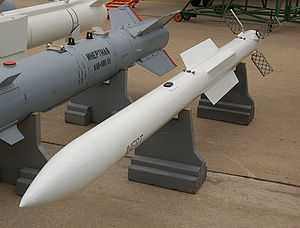 |
AA-12 Adder | |
air-to-air missile | RVV-AE | Su-30MK2 Su-27SKM |
– | .. |
 |
AS-10 Karen | |
anti-ship missile | Kh-25ML Kh-25MP/Kh-25MPU Kh-25MR |
Su-22M4 | ||
 |
AS-9 Kyle | |
anti-ship missile | Kh-28E | Su-22M4 | [42] | |
.jpg) |
AA-2 Atoll | |
anti air-to-air | R-3S | Mig-21 | ||
 |
AA-8 Aphid | |
anti air-to-air | R-60 | Mig-21 |
Retired:
-
 Czechoslovakia Zlín Z-226 Trener – basic trainer (8)
Czechoslovakia Zlín Z-226 Trener – basic trainer (8) -
 Czechoslovakia Aero Ae-45 – trainer (3)
Czechoslovakia Aero Ae-45 – trainer (3) -
 Czechoslovakia Aero L-29 Delfin – jet trainer (12)
Czechoslovakia Aero L-29 Delfin – jet trainer (12) -
 USSR Lisunov Li-2 Cab – transport (24)
USSR Lisunov Li-2 Cab – transport (24) -
 USSR Ilyushin Il-28 Beagle – medium bomber (16)
USSR Ilyushin Il-28 Beagle – medium bomber (16) -
 USSR Ilyushin Il-14 Crate – transport (45)
USSR Ilyushin Il-14 Crate – transport (45) -
 USSR Ilyushin Il-18 Coot – transport (7)
USSR Ilyushin Il-18 Coot – transport (7) -
 USSR Mikoyan-Gurevich MiG-15 Fagot – jet fighter (50)
USSR Mikoyan-Gurevich MiG-15 Fagot – jet fighter (50) -
 USSR Mikoyan-Gurevich MiG-17 Fresco – jet fighter (77)
USSR Mikoyan-Gurevich MiG-17 Fresco – jet fighter (77) -
 USSR Mikoyan-Gurevich MiG-19 Farmer – jet fighter (45)
USSR Mikoyan-Gurevich MiG-19 Farmer – jet fighter (45) -
 USSR Sukhoi Su-7 Fitter- fighter-bomber (30)
USSR Sukhoi Su-7 Fitter- fighter-bomber (30) -
 USSR Yak-40 Codling – transport (15)
USSR Yak-40 Codling – transport (15) -
 USSR Mi-4 Hound – VIP transport – (1) – used as Ho Chi Minh's transport helicopter.
USSR Mi-4 Hound – VIP transport – (1) – used as Ho Chi Minh's transport helicopter. -
 Poland Mil Mi-2 Hoplite Hoplite – light helicopter (24)
Poland Mil Mi-2 Hoplite Hoplite – light helicopter (24) -
 United States Douglas A-1 Skyraider – prop attack aircraft (21)
United States Douglas A-1 Skyraider – prop attack aircraft (21) -
 United States Sikorsky CH-34 Choctaw – helicopter (34)
United States Sikorsky CH-34 Choctaw – helicopter (34) -
 United States Cessna A-37 Dragonfly – jet attack aircraft (95)
United States Cessna A-37 Dragonfly – jet attack aircraft (95) -
 United States Northrop F-5 Freedom Fighter – supersonic light fighter (8 that haven't been auctioned off)
United States Northrop F-5 Freedom Fighter – supersonic light fighter (8 that haven't been auctioned off) -
 United States Northrop F-5E Tiger II – supersonic light fighter (1) – Lt. Nguyễn Thành Trung was pilot when he bombed the Republic South Vietnam Presidential Palace on morning of April 5, 1975 then fled to Phước Long airfield where he was received by North Vietnam Forces.
United States Northrop F-5E Tiger II – supersonic light fighter (1) – Lt. Nguyễn Thành Trung was pilot when he bombed the Republic South Vietnam Presidential Palace on morning of April 5, 1975 then fled to Phước Long airfield where he was received by North Vietnam Forces. -
 United States Northrop F-5B Freedom Fighter – supersonic trainer (3)
United States Northrop F-5B Freedom Fighter – supersonic trainer (3) -
 United States Douglas C-47 Skytrain – transport & gunship (16)
United States Douglas C-47 Skytrain – transport & gunship (16) -
 United States Fairchild C-119 Flying Boxcar – medium transport (5) – 1 gunship lost with crews, in battle on April 29, 1975, Captain Trang văn Thắng was pilot
United States Fairchild C-119 Flying Boxcar – medium transport (5) – 1 gunship lost with crews, in battle on April 29, 1975, Captain Trang văn Thắng was pilot -
 United States Lockheed C-130 Hercules – medium transport (4)
United States Lockheed C-130 Hercules – medium transport (4) -
 United States Boeing CH-47 Chinook – heavy-lift helicopter (23)
United States Boeing CH-47 Chinook – heavy-lift helicopter (23) -
 United States Cessna O-1 Bird Dog – army co-operation/light recon (19)
United States Cessna O-1 Bird Dog – army co-operation/light recon (19) -
 United States North American T-28 Trojan – basic trainer/light attack (14)
United States North American T-28 Trojan – basic trainer/light attack (14) -
 United States Cessna T-37 Tweet – jet trainer (9)
United States Cessna T-37 Tweet – jet trainer (9) -
 United States UH-1 Iroquois – helicopter (42) – except 15 UH-1H still in flight
United States UH-1 Iroquois – helicopter (42) – except 15 UH-1H still in flight
Some jet fighters (F-5s and A-37s) were auctioned in 1998, and are currently owned by private companies, and individuals in America, Australia, New Zealand, and Europe.
The current procurement plan of the VPAF is to equip up to 3 regiments with 3 x 12 Sukhoi Su-30 "Flanker" until 2015. VPAF already upgraded its air defense system with more effective missile system such as Buk missile system and Pantsir-S1 system. Vietnam may be the third customer to buy the S-400 Triumf missile system around 2017[43]
See also
| Wikimedia Commons has media related to Vietnam People's Air Force. |
- Battle of Phou Pha Thi, (Northeastern Laos, 12 January 1968)
- Republic of Vietnam Air Force
- Vietnam People's Air Force Museum, Hanoi
- Vietnam People's Air Force Museum, Ho Chi Minh City
- Colonel Nguyen Toon
Notes
References
- ↑ 1.0 1.1 1.2 1.3 1.4 1.5 1.6 1.7 1.8 1.9 1.10 Ivanov, S.V. (2000). "Boyevoye primenenye MiG-17 i MiG-19 vo Vietnamye (Боевое применение МиГ-17 и МиГ-19 во Вьетнаме)". Voyna v vozdukhye (16).
- ↑ Sander Peeters. "Vietnamese Air-to-Air Victories, Part 1 - www.acig.org". Retrieved 24 December 2014.
- ↑ "Vietnamese Air-to-Air Victories, Part 2." ACIG. Retrieved: 25 August 2013.
- ↑ "Vietnamese Aces – MiG-17 and MiG-21 pilots". Acepilots.com. Retrieved 2013-08-09.
- ↑ 5.0 5.1 5.2 5.3 5.4 "Mig-21 against the Phantom".
- ↑ "Vietnamese Air-to-Air Victories, Part 2". Retrieved 24 December 2014.
- ↑ Anderton 1987, pp. 70–71.
- ↑ Sherman, Stephen (October 2002). "Randy Cunningham". Acepilots.com.
- ↑ Hall, George (1987). Top Gun: The Navy's Fighter Weapons School. Presido Press.
- ↑ "Vạch nhiễu tìm thù hạ "ngáo ộp" B52". Tin nhanh Việt Nam ra thế giới (World News Vietnam) – Vietbao.vn. 23 December 2007.
- ↑ See "Published Government Documents" and "Secondary Sources" below.
- ↑ Migs over North Vietnam: The Vietnam People's Air Force in Combat, 1965–75, Stackpole Military History
- ↑ 13.0 13.1 ACIG Team (16 September 2003). "Vietnamese Air-to-Air Victories, Part 1". Indochina Database. Air Combat Information Group.
- ↑ 14.0 14.1 ACIG Team (16 September 2003). "Vietnamese Air-to-Air Victories, Part 2". Indochina Database. Air Combat Information Group.
- ↑ Aviaciya PVO Rossii i nauchno-technicheskii progress. Boevie kompleksi i sistemi vchera, segodnya, zavtra", E.A.Fedosova, Drofa, 2004
- ↑ Toperczer (29) p. 80, 81
- ↑ 17.0 17.1 17.2 Blagov, Sergei (5 September 2003). "Russian missiles to guard skies over Vietnam". Asia Times Online (Moscow).
- ↑ "Su-17,-20,-22 FITTER (SUKHOI)". GlobalSecurity.org.
- ↑ "MiG-21 FISHBED". GlobalSecurity.org.
- ↑ Bowers, Al; Lednicer, David (17 May 1999). "Fighter Pilot Aces List". The Air University.
- ↑ ŠAFAŘÍK, Jan Josef (20 December 2010). "VIETNAM: War In Vietnam".
- ↑ MiG-17 and MiG-19 Units of the Vietnam War by István Toperczer
- ↑ Flightglobal Insight | World Air Forces 2011/2012
- ↑ 24.0 24.1 "World Air Forces 2013". Flight International.
- ↑ 25.0 25.1 25.2 25.3 "Free download: World Air Forces directory 2014". The DEW Line. Retrieved 24 December 2014.
- ↑ "Vietnam Received Two More Su-30MK2". December 12, 2014.
- ↑ 27.0 27.1 http://asian-defence-news.blogspot.com/2014/12/russia-completes-delivery-of-all-su.html
- ↑ "Ukraine to Repair Engines of Vietnamese Su-27 Aircraft". July 23, 2013.
- ↑ Reed Business Information Limited. "Multiple engine failure blamed for An-124 Irkutsk accident". Retrieved 24 December 2014.
- ↑ http://indianexpress.com/article/world/asia/vietnamese-sukhoi-fighter-jets-collide-during-training/
- ↑ http://indianexpress.com/article/world/asia/vietnamese-sukhoi-fighter-jets-collide-during-training/
- ↑ "Vietnam Air Force Purchased 3 Transport Aircraft C-295". June 12, 2014.
- ↑ "World Air Forces 2014", Flightglobal
- ↑ http://phunutoday.vn/xahoiol/tieudiem/201111/Bao-Trung-Quoc-noi-ve-may-bay-tuan-tieu-M28-cua-Viet-Nam-2110299/
- ↑ "Vietnam Successfully Tests First Unmanned Aircraft". May 5, 2013.
- ↑ "Vietnam UAV Flying at Night, Facing the South China Sea". May 28, 2013.
- ↑ "ZSU-23-4". Jane's Information Group. 2008-10-30. Retrieved 2008-11-08.
- ↑ 38.0 38.1 "Thống kê hợp đồng mua sắm đạn dược của Việt Nam". Retrieved 24 December 2014.
- ↑ "Việt Nam mua tên lửa chống hạm siêu âm cho Su-30MK2" [The Philippines bought supersonic anti-ship missile for Su-30MK2]. VietnamDefence.com. 18 July 2008.
- ↑ "Soviet Missiles: Air-to-Surface Missiles".
- ↑ 41.0 41.1 "Vietnam Arranges Event for Media for the Su-30MK2 Missile". April 1, 2013.
- ↑ Kopp, Dr Carlo (August 2009), Soviet/Russian Tactical Air to Surface Missiles (Technical Report APA-TR-2009-0804), Air Power Australia (http://www.ausairpower.net)
- ↑ "Việt Nam là khách hàng mua S-400 thứ ba" [Vietnam is the third S-400 buyer]. Vietnam Press (baodatviet.vn). 24 March 2012.
Published Government Documents
- Boyne, Walter J. (May 1997). "Linebacker II". Air Force Magazine 80 (11).
- Gilster, Herman L. The Air War in Southeast Asia: Case Studies of Selected Campaigns. Maxwell Air Force Base AL: Air University Press, 1993.
- Head, William P. War from Above the Clouds: B-52 Operations During the Second Indochina War and the Effects of the Air War on Theory and Doctrine. Maxwell AFB AL: Air University Press, 2002.
- McCarthy, Brig. Gen. James R. and LtCol. George B. Allison, Linebacker II: A View from the Rock. Maxwell Air Force Base AL: Air University Press, 1979.
- Nalty, Bernard C. Air War Over South Vietnam: 1969–1975. Washington, D.C.: Center of Air Force History, 1995.
- Schlight, John, A War Too Long. Washington, D.C.: Center of Air Force History, 1993.
- Tilford, Earl H. Setup: What the Air Force Did in Vietnam and Why. Maxwell Air Force Base AL: Air University Press, 1991.
- Thompson, Wayne, To Hanoi and Back: The U.S. Air Force and North Vietnam, 1966–1973. Washington, D.C.: Smithsonian Institution Press, 2002.
Secondary Sources
- Asselin, Pierre, A Bitter Peace: Washington, Hanoi and the Making of the Paris Agreement, Chapel Hill: University of North Carolina Press, 2002.
- Ambrose, Stephen E., The Christmas Bombing in Robert Cowley, ed. The Cold War: A Military History, New York: Random House, 2005.
- Casey, Michael, Clark Dougan, Samuel Lipsman, Jack Sweetman, Stephen Weiss, et al., Flags Into Battle. Boston: Boston Publishing Company, 1987.
- Dorr, Robert. Boeing's Cold War Warrior: B-52 Stratofortress. Osprey Publishing, 2000. ISBN 978-1-84176-097-1
- Drendel, Lou, Air War over Southeast Asia: Vol. 3, 1971–1975. Carrollton TX: Squadron/Signal Publications, 1984.
- Hobson, Chris, "Vietnam Air Losses USAF/NAVY/MARINE, Fixed-wing aircraft losses Southeast Asia 1961–1973. 2001. ISBN 1-8578-1156
- Karnow, Stanley, Vietnam: A History. New York: Viking Books, 1983.
- Lipsman, Samuel, Stephen Weiss, et al., The False Peace: 1972–74. Boston: Boston Publishing Company, 1985.
- Littauer, Raphael and Norman Uphoff, The Air War in Indochina. Boston: Beacon Press, 1972.
- McCarthy, Donald J. Jr. MiG Killers: A Chronology of US Air Victories in Vietnam 1965–1973. North Branch, Minnesota: Speciality Press, 2009. ISBN 978-1-58007-136-9.
- Morocco, John, Rain of Fire: Air War, 1969–1973. Boston: Boston Publishing Company, 1985.
- Pribbenow, Merle L.(trans) Victory in Vietnam: The Official History of the People's Army of Vietnam. University Press of Kansas, 2002. ISBN 0-7006-1175-4
- Zaloga, Steven J. Red SAM: The SA-2 Guideline Anti-Aircraft Missile. Osprey Publishing, 2007. ISBN 978-1-84603-062-8
External links
- Vietnamese's Air-to-Air Victories
- Vietnamese Aces
- Vietnam Air Force Museum
- Ace Pilots North Vietnam Aces
| ||||||||||||||||||||||
| ||||||||||||||||||||||

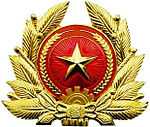
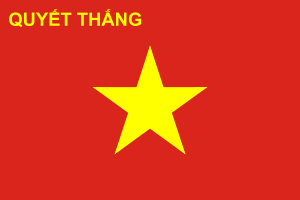
.svg.png)